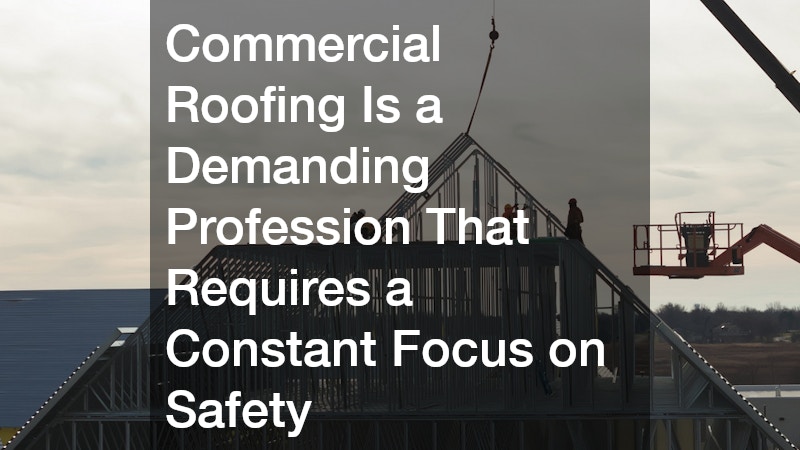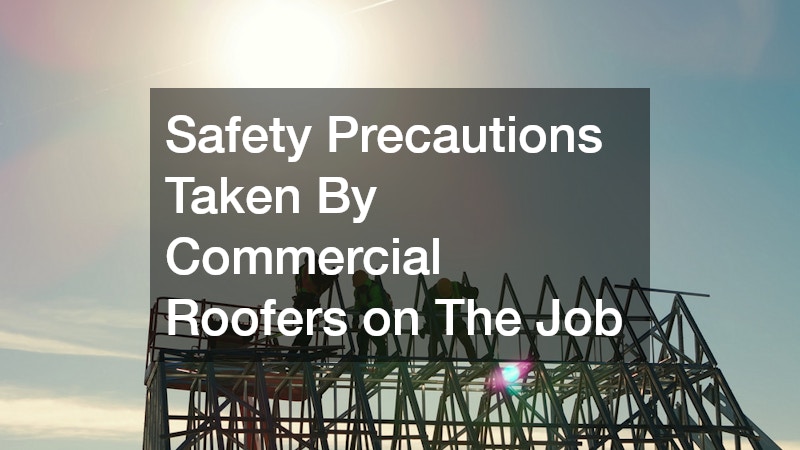Working on commercial roofing projects is a physically demanding and potentially hazardous profession. The combination of elevated work areas, heavy materials, and specialized tools creates a work environment where safety must always come first. Commercial roofers follow strict protocols and utilize proven safety measures to protect themselves, their coworkers, and the surrounding property. These precautions are not just best practices; they are often required by workplace regulations and industry standards to minimize the risk of accidents.
Conducting Thorough Job Site Assessments
Before any roofing work begins, experienced crews perform a detailed job site assessment. This involves identifying hazards such as unstable structures, exposed electrical lines, or weather conditions that could affect the safety of the project.
Assessments also take into account the layout of the building, nearby pedestrian areas, and the placement of equipment. By spotting potential risks ahead of time, commercial roofers can create a targeted safety plan that addresses site-specific concerns and prevents incidents before they occur.
Utilizing Proper Fall Protection Systems
Falls are one of the most significant risks in roofing work. To prevent them, teams use a combination of guardrails, safety nets, and personal fall arrest systems. These systems are designed to either stop a fall in progress or prevent a worker from reaching a fall hazard in the first place. Workers are trained on how to properly fit and inspect harnesses, secure lifelines, and ensure anchor points meet safety standards. Using this equipment consistently is one of the most effective ways to safeguard against serious injuries.
Wearing the Right Personal Protective Equipment
Personal protective equipment (PPE) is a non-negotiable part of roofing safety. Hard hats protect against falling debris, gloves shield hands from sharp edges and hot materials, and steel-toe boots reduce the risk of foot injuries. In addition, high-visibility clothing ensures that workers remain easily seen by others, especially on busy job sites. Eye and ear protection may also be necessary when cutting materials or operating loud machinery. Proper PPE is essential for reducing the likelihood of injury during day-to-day tasks.
Practicing Safe Material Handling
Commercial roofing materials such as rolls of membrane, metal sheets, or buckets of adhesive can be heavy and awkward to maneuver. Improper lifting techniques or moving materials without assistance can lead to strains, sprains, or back injuries. Roofers are trained in safe material handling, which includes using equipment like hoists, cranes, or conveyor systems to transport materials to elevated work areas. When heavy items must be moved manually, teamwork and correct lifting posture help prevent injury.
Maintaining Clear Communication
Good communication is a vital safety precaution in commercial roofing. Crew members use hand signals, radios, or verbal cues to coordinate movements, warn others about hazards, and share important updates. Clear communication is especially important when operating machinery, moving materials, or working in limited visibility conditions. By ensuring that everyone knows their role and understands the day’s safety plan, teams reduce the chance of misunderstandings that could lead to accidents.
Adapting to Weather Conditions
Weather plays a major role in roofing safety. High winds, rain, snow, or extreme heat can all create unsafe working conditions. Commercial roofers monitor forecasts and adjust schedules when necessary to avoid unnecessary risks. For example, they may postpone work during thunderstorms or high wind advisories to prevent falls or equipment mishandling. On hot days, frequent breaks and hydration are prioritized to prevent heat-related illnesses. Being adaptable ensures that safety is never compromised by environmental factors.
Keeping Tools and Equipment in Top Condition
Rooftop work requires specialized tools, from power drills and nail guns to cutting equipment and heat welders. If these tools are damaged or poorly maintained, they can pose a serious safety risk. Regular inspections help identify worn parts, frayed cords, or other issues that could cause malfunctions. Crews are trained to store tools properly and report any damage immediately. Using well-maintained equipment not only improves efficiency but also significantly reduces the potential for injury.
Following Industry Training and Compliance Standards
Safety in roofing isn’t left to chance—it’s reinforced through ongoing training. Workers learn proper installation techniques, equipment operation, and emergency response procedures. Many companies require certifications for operating lifts, handling hazardous materials, or working at certain heights. Compliance with standards set by organizations such as OSHA helps ensure that all safety protocols meet or exceed industry requirements. This commitment to education and compliance fosters a culture where safety is second nature.
Commercial roofing is a demanding profession that requires a constant focus on safety. Through careful planning, proper equipment use, clear communication, and adherence to industry regulations, commercial roofers can protect themselves and others while delivering high-quality results. Every precaution taken on the job—whether it’s inspecting a harness, waiting out a storm, or conducting a site assessment—reflects a commitment to not just getting the job done, but getting it done safely. This dedication ensures that both workers and clients can have peace of mind throughout the entire roofing process.


